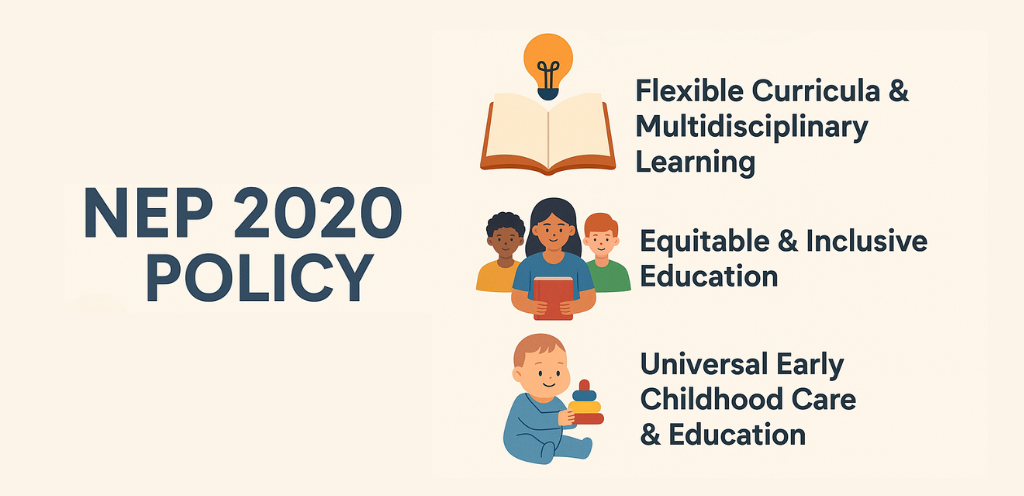NEP 2020 Language Policy Explained: A Must-Read for Educators
Ritika Tiwari
Posted on August 5, 2025

Language goes beyond simply being a tool of communication. It plays a vital role in shaping how children learn, express themselves, and connect with the world around them. Recognising this, the National Education Policy 2020 has introduced changes to how languages are taught in schools across India. Let’s take a closer look at the key features of the policy, especially the Three-Language Formula, and what it means for students and educators alike.
What are the Key Features of the NEP 2020 Regarding Languages?
The National Education Policy 2020 has changed the way language is approached within the educational system in Indian schools. It aims to promote multilingualism while helping students stay connected to their roots. Here are some of the key highlights:
Three-Language Formula
In the recent changes brought to the NEP 2020 language policy, students have to learn three languages in school, with at least two of them being native to India. The specific languages will be decided by states, regions, and students, as long as they meet the basic requirements.
Promoting Mother Tongue
Wherever possible, the medium of instruction till at least Grade 5 (ideally through Grade 8, until the child reaches a higher educational level) will be the mother tongue or regional language. This helps young learners grasp concepts better.
No Language Imposition
The NEP policy for languages highlights the importance of flexibility and choice. It clearly states that no language will be imposed on any student.
Inclusion of Sanskrit and Other Classical Languages
Sanskrit will be offered at all levels, and students will also have the chance to explore other classical and foreign languages.
What is the Three-Language Formula?
The Three-Language Formula is a key part of India’s language policy in the NEP 2020, designed to encourage multilingualism and cultural understanding from an early age. It gives students the opportunity to learn multiple languages without burdening them.
In the three-language policy of NEP 2020, students have to take three languages, of which two should be Indian languages. Below are the highlights of this NEP feature:
- Flexible Implementation: The choice of languages is left to states, schools, and students, allowing flexibility based on regional and individual needs.
- Promotes Cultural Connection: By learning regional and classical languages, students develop a stronger connection to their culture and heritage.
- Encourages Language Proficiency: This approach is meant to help students become proficient in multiple languages, boosting their communication and cognitive skills.
- No Forced Learning: The policy ensures that no language will be forced upon any student, supporting a more learner-centric environment.
What is the Impact of NEP 2020 Language Policy on Educators and Students?
While the language policy in NEP 2020 focuses on creating a more inclusive and culturally rooted learning environment, it also asks a lot from both students and educators. Here’s a quick look at how the language formula is making an impact:
For Educators:
- Teachers are now expected to teach in multiple languages, which requires training in new teaching strategies and classroom management techniques.
- There’s a strong push towards tech-based learning and the adoption of modern teaching approaches.
- Schools have to emphasise continuous professional development programmes to help educators stay updated with the latest methods in teaching and assessment.
- The policy promotes formative and competency-based assessments, allowing teachers to better support individual student needs.
- Educators will need additional resources, infrastructure, and support systems to bring these changes to life effectively.
For Students:
- Learning in the mother tongue until Grade 5 helps children understand concepts better, boosting cognitive development and improving comprehension in their early years.
- Multilingual education nurtures appreciation for cultural heritage while also preparing students to communicate effectively in a global setting.
- Students are encouraged to pick subjects and languages from Grade 6, allowing for more personalised learning based on interests.
- With less focus on high-stakes exams and more on continuous assessments, students are developing problem-solving skills and critical thinking at their own pace.
- Exposure to classical languages and literature adds depth to their understanding of India’s rich linguistic and cultural history.
Language is a bridge to understanding culture, identity, and communication. With the introduction of the Three-Language Formula and the language-focused reforms under the National Education Policy 2020, India is taking a thoughtful step towards creating a multilingual, inclusive, and learner-friendly education system. By encouraging children to learn multiple languages while staying rooted in their mother tongue, the policy strikes a meaningful balance between global readiness and cultural pride.



